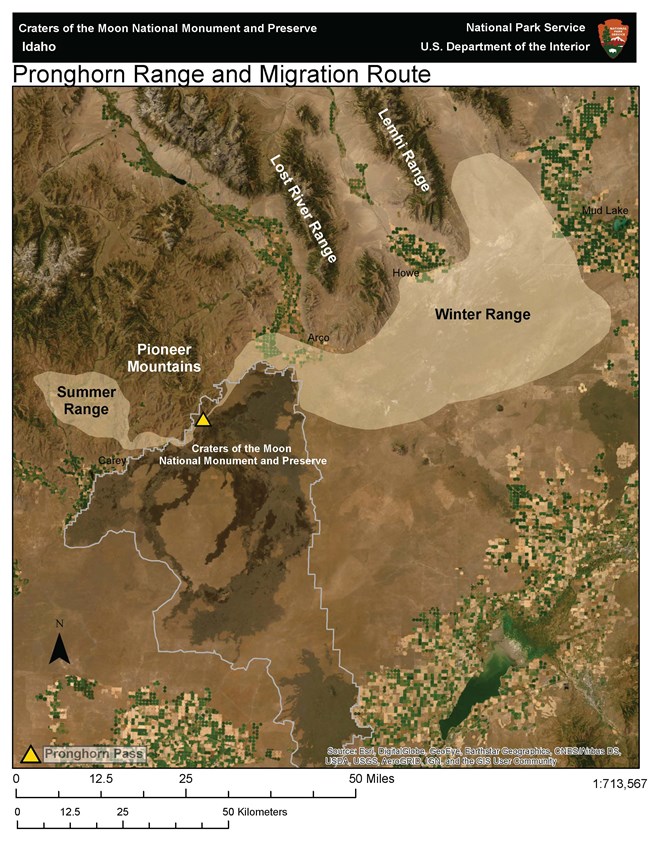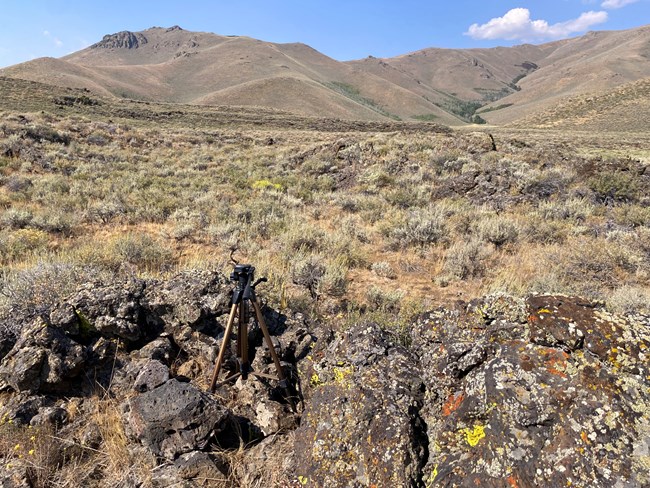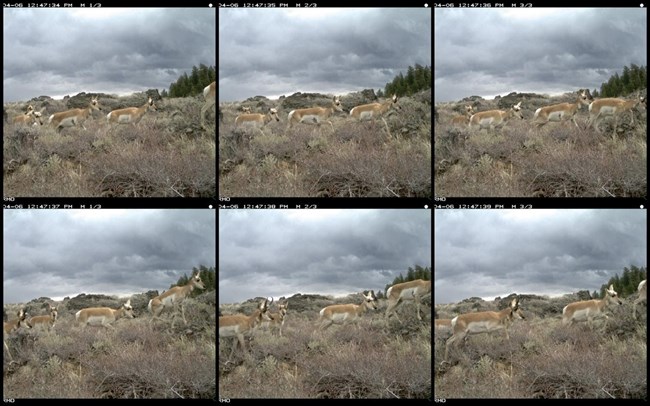Last updated: January 27, 2024
Article
Capturing Pronghorn Migration at Craters of the Moon
Pronghorns (Antilocapra americana) were one of the most common animals in the North American plains during the early 1800s with estimated population numbers of 35 million. However, populations drastically declined during Western Expansion due to hunting, development of towns and roads, and harmful fencing surrounding sheep and cattle ranches.
Pronghorns typically migrate in the fall to warmer locations with more readily available food. In the spring, the pronghorns return to their summer range to raise their young. At Craters of the Moon National Monument and Preserve, scientists are uncovering the fine details of biannual migration patterns in Southern Idaho.

NPS Image
The Beginnings of Research
Wildlife biologists at Craters of the Moon have known since the 1960s that pronghorns move through the north end of the park. However, recent studies help park staff better-understand local pronghorn population behaviors.
In 2008, the Lava Lake Institute captured and fitted ten pronghorns from the Pioneer Mountains with Global Positioning System (GPS) collars to collect data on where these animals spend their winters. Scientists were surprised to find that some Pioneer Mountain pronghorns migrated about 100 miles east to join the largest wintering herd in Idaho on the Big Desert/Idaho National Laboratory Range.
The Lava Lake study continued the following year with additional partners, including the Wildlife Conservation Society and Idaho Department of Fish and Game. Results from GPS collar data identified five additional routes that traveled to and from, and even stayed within, the Idaho National Laboratory Range.
One of the five routes revealed an 8.5-mile migration path through Craters of the Moon. The narrowest funnel of this corridor is between the foot of the Pioneer Mountains and Sunset Cone at the north end of the park. This area is now called “Pronghorn Pass.”
Although scientists recently discovered this path, obsidian arrowheads found along the migration trail suggest that the area’s indigenous peoples understood the migration patterns and hunted along the path. Craters of the Moon National Monument and Preserve is ancestral land of the Shoshone and Bannock tribes and pronghorn was a staple in their diet.

NPS Photo
Opportunity at Pronghorn Pass
The proximity of Sunset Cone (the northernmost volcanic peak in the park) to the Pioneer Mountains creates a natural funnel the animals must pass through. Topography within the pass (lava ridges and outcrops) further funnels pronghorns onto a narrow path through the park. In fact, the pronghorns commonly travel across the lavas of Craters of the Moon a single file manner! Todd Stefanic, Wildlife Biologist at Craters of the Moon, hypothesizes this behavior is a predator avoidance strategy, as the proximity of the Pioneer Mountains and the park’s rugged lava terrain afford ample hiding places for predators and limit visibility for the pronghorns. This terrain is much different than the open rangelands pronghorns are accustomed to.
Wildlife biologists recognized the concentrated migration corridor through the park as a unique opportunity to study pronghorn migration and learn how many pronghorns move through the park and what time of year, or even time of day, the animals migrate.
Capturing Answers Regarding a Regionally Significant Migration Route

Since 2012, wildlife biologists at Craters of the Moon have placed motion-activated trail cameras at Pronghorn Pass to document the migrating animals. In some years, park biologists deploy an additional camera where the migration trail meets the fenced park boundary.
NPS biological science technicians and trained interns or volunteers analyze captured images to count the pronghorns and track the date and time the animals migrate through the park. To maintain an accurate count, researchers use identifying characteristics such as white markings on the neck, markings around the face, horns, shedding fur, scars, and body size to differentiate individuals across photos.
The analysis of the data revealed that an average of 400 pronghorns migrate through Craters of the Moon each spring and fall. Up to 700 have been captured in a single migration! Scientists found that while fall migration begins in September and peaks in October, and spring migration occurs mainly throughout March and April, the migration window varies and is mainly tied to snow and forage conditions on the summer and winter ranges. Further, pronghorns tend to move through the park between noon and 5 p.m. in the spring, whereas the highest concentration of movement is between 10 a.m. and 1 p.m. in the fall.
Implications of this Study
Understanding pronghorn migration through the park guides management decisions at Craters of the Moon to reduce human interference with the animals. Park management schedules service road maintenance near Pronghorn Pass during times of the year when pronghorns are not migrating. If staff must travel the service road during migration, they do so at off-peak migration times of the day. Additionally, if park staff encounter migrating pronghorns, they know to slowly approach and back away.

Despite their speed and agility, pronghorns do not attempt to jump over fences, but instead crawl under. Images from the park boundary revealed that the fence was a dangerous obstacle that entangled some of the migrating pronghorns. In response, Craters of the Moon staff converted boundary fencing to a wildlife friendly design that pronghorns and other wildlife can pass through with ease.
Data collected in the remote camera study and the 2008/2009 GPS study also support management decisions to address migration barriers (such as roads, fences, and development) and reduce pronghorn mortality within and beyond park boundaries. Park wildlife biologists have partnered with the Natural Resources Conservation Service (NRCS) to work with surrounding landowners and convert their fences to the wildlife friendly design. NRCS assists additional ranchers along the migration route in southern Idaho to convert their fences to this design too.
How Can You Help?
When visiting Craters of the Moon, drive slow through the park to reduce the chance of a wildlife collision. Additionally, check with park rangers to learn if certain areas of the park are closed to protect migrating pronghorns.
NPS science, like the work at Craters of the Moon, is critical to understanding the natural world. In turn, the National Park Service makes informed management decisions today to protect park resources for tomorrow.
